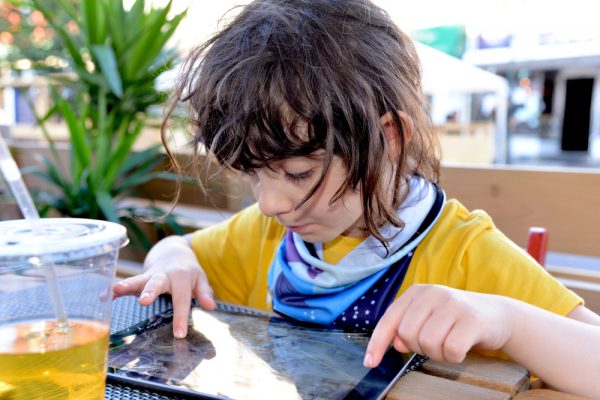
Para español, haga clic aquí
Increased family bonding is one of the most commonly discussed benefits of family meals. But when families include members with autism, ADHD, or other learning and developmental differences, developing those bonds at the table can be challenging. Caregivers and siblings might need to work on finding new ways to adapt their communication styles or expectations so that everyone feels comfortable, connected, and included.
“We know that food and eating are supposed to be social,” says Naureen Hunani, RD., a pediatric and family dietitian who specializes in neurodiversity. “The social function is something that parents are concerned about.” But that concern for a child’s social interaction skills, combined with a sense that family mealtimes are supposed to enhance relationships and communication, can sometimes add unnecessary pressure. Parents may feel that they have to use interactions at the dinner table as an opportunity to “work on” social skills goals for their child, which can make the family meal feel more like a clinical environment than a place to relax.
“It all comes down to goals,” says Bob Cunningham, Executive Director of Learning Development for Understood. “Dinner time doesn’t have to be practice time.” He adds that for parents who are already stretched thin, “overprogramming” family time with social interventions can be exhausting. “Parents get tired of scheduling everything around their kids’ lives,” he points out. “There’s not enough out there about non-goal-oriented time.”
Still, creating a low-pressure environment for family meals and resisting the urge to make dinnertime overly therapeutic is easier said than done. And even for parents with the best of intentions, common challenges with conversation, turn-taking, interrupting, and social cues can cause frustration – or a breakdown of sibling relationships. We asked Hunani, Cunningham, and a group of other experts to answer some real-life questions from families about making family meals inclusive.

My child has trouble jumping into fast-moving conversations at the table. What should we do?
Dr. Martha Straus, psychologist, professor, and author of Cool, Calm, and Connected, answers this question bluntly: “Why are you having fast-moving conversations with a child who struggles with this? Fast-moving, loud conversations can be overwhelming. It’s a lot easier for parents to communicate like their child, than vice-versa.”
Dr. Nora Friedman, Clinician at the Lurie Center at MGH, agrees. “Slow down the conversation.” She also points out that the dinner table can be a noisy environment, which may be distracting and contribute to conversational issues for a child with slower processing speed or sensory challenges. Friedman recommends minimizing background noise, and possibly choosing one or two conversation topics in advance. “Give the child a heads-up: ‘We’re going to talk about this news item or what you did at school today’ so the child can prepare for the conversation and not feel caught off-guard.”
Preparing in advance for topics, and figuring out a subtle system for changing subjects, are also on Cunningham’s list of recommendations. “The kids who have the hardest time with siblings are the ones with slow processing,” he says. “If the pace of the conversation isn’t in keeping with the siblings’ pace, that’s really a problem. Dinner conversation doesn’t usually adhere to the structured conversation of other settings (like school). If there’s a theme in place, then kids can figure out what’s happening.”
He points out that any small amount of predictability in dinner conversation can build confidence and success. Families might start each meal with an activity like Rose, Thorn, and Bud to help kids easily anticipate what the discussion will be like from night to night. But, Cunningham notes, “You can still have a family structure that allows everyone to talk about what they want. Make sure that each person says that they’re going to change the subject, or have them introduce the new subject and then pause. Parents can also impose a break by saying ‘Take a moment and think while you pass me the salt.’”
Parents can also help facilitate a less structured conversation by adding some verbal cues and support. Jennifer Stornelli, Pediatric Occupational Therapist and head of the Pediatric Feeding Program at Spaulding Outpatient Center for Children in Lexington, encourages adult caregivers to find natural pauses in the conversation. “Summarize for your child what you’re talking about and ask them a simple related question, giving extra time for their response,” she advises. “And whenever possible, keep the mealtime conversations at a pace that fits your child, and keep the content relatable to all the present family members.” For example, a parent might say “Sam, I was just listening to what your brother said about his experience with his teacher today. It sounded to me like he felt what the teacher did was unfair. Have you ever felt that way about one of your teachers?” If another family member tries to change the subject or interrupt before Sam is able to respond, the parent might say “Hold on – I think Sam’s still thinking about what he wants to say. Let’s all enjoy a few bites of our food while he’s getting ready to share.”

My husband and one of my kids are very talkative, but another child, who is on the autism spectrum, has trouble with conversational turn-taking. Unfortunately when we’re at dinner together, the other family members get absorbed in their conversation and don’t remember to make space for him to join in, or they get annoyed when he contributes by talking about his special interests. He needs the practice in conversation skills – what should we do?
“His talking about dinosaurs isn’t going to hurt anyone,” Cunningham points out, reminding parents again that dinner doesn’t have to be the time to work on conversation skills for a child on the spectrum. “Perhaps that setting isn’t practice time. This isn’t a child who is ready to participate smoothly in random conversation, so give him a chance to talk.” But, he cautions, letting the child talk about his special interest doesn’t mean that everyone just waits for him to finish a monologue, then goes back to their own discussions. “Just giving the child a turn isn’t really going to help. Have everyone participate in a little conversation about dinosaurs, and make room for that. It’s just a trade-off. It’s more on the family to accommodate.”
“What is making it so hard to give space and time to the other child?” Friedman asks, recommending that the family start by asking themselves that question to see if it sparks any ideas or understanding about how the others might adapt. She also agrees with Cunningham that the child’s desire to talk about a special interest should be honored, but she offers a compromise that might help with the parents’ desire to work on conversational skills. “We’ll set a timer for you to talk about Pokemon for five minutes, then give everyone else a chance to talk about something special from their day.” Friedman also notes that some kids might be ready to prepare two questions they can ask of their siblings at dinnertime, so after they’ve had their moment to share about a special interest, they can practice reciprocity by asking a question of someone else at the table.
Megan Mayo, MA, BCBA, LBA and doctoral candidate in clinical psychology at Antioch University New England, adds that the whole family might benefit from working on conversational turn-taking. She suggests trying some games that reinforce turn-taking, like Roll the Orange. She also recommends having a prompt in place, like a cue card or a signal, that reminds the speaker to ask a question of someone else at the table. With whole-family games and signals in place, practicing becomes less about one child who “needs help,” and more about helping everyone remember to make space for each other in the conversation.

My child is just getting used to using Assistive Technology/Augmentive and Alternative Communication (AAC) for communication. How can we help the whole family learn to be patient with this new tool and use it to allow everyone to be a part of the conversation?
“I’m really pleased to hear this question,” says Dr. Robyn Thom, Child and Adult Psychiatrist at the MGH Lurie Center for Autism. She shares that often, because families are able to understand the cues given by a child with limited verbal communication, AAC might not be used as much in family settings. Thom adds, “I think it’s really important for kids to use the device across all settings, so it’s important for the child to use it at home so it becomes a primary method of communication. But the child may be too tired to use it (at meals).” She encourages families to think first about whether the child and family are ready to introduce AAC at dinner. “Is dinner the place to introduce it? Maybe if there are multiple kids, it may feel like too much. You could start with using it with just one parent. Or you could get tips from the child’s school on how they are using it, so you can replicate that (at home).”
Mayo also encourages parents to seek expert help in implementing AAC at mealtimes. “I have seen teams acquire the device for a family and simply expect it to fix all communication difficulties right out of the box,” she says. She offers tips for helping families use the devices to encourage social interaction at dinner: “Start with high-payoff interactions! Program in greetings and jokes, and program in requests for high-preference items and activities,” she advises. “Also, make sure to have it programmed for two-way interactions, not just requests.” To ease the inevitable awkwardness that will occur while the child and family get used to using AAC, Mayo recommends having one person who is fluent in using the device – this could be an outside expert, or a parent who has been trained – sit with the child and help model use of AAC. “And normalize awkwardness,” Mayo says. “It’s like using a foreign language. It takes extra time to process communication, and it will take time to build fluency!”
Stornelli advises making sure that everyone in the family understands that learning curve. “Let other family members know that the child may need extra time to reply as he navigates the device, and that we all want to make sure he gets that time to communicate his thought or idea,” she says. “Provide opportunities for all the family members to get some training using the device, so they can help him when he gets stuck. You can pull the Speech/Language Pathologist in for that support.” She also agrees that pre-programming the device with dinner conversation in mind can be helpful, recommending that families think of “things that are more narrative in nature, like a blurb about what he did at school that day, if sharing about his day at the family meal is a typical part of the routine.”
Melanie Potock, MA, CCC-SLP adds that just as with any conversational turn-taking, establishing family signals can be helpful. “A tug on your earlobe or scratching the tip of your nose to quietly indicate it’s your child’s turn to use their AAC and be a part of the conversation gives everyone a chance to quietly pause and attend, without creating frustration at the table.”
In the end, choosing how to manage conversational challenges when a child has been diagnosed with ADHD, autism, or learning and developmental disorders is as much about helping the whole family adapt as it is about helping that child communicate. Expecting neurotypical conversation patterns from a neurodivergent child is bound to be frustrating and upsetting for everyone. Introducing conversational routines like a daily set of questions, setting family expectations around turn-taking and patience, and keeping things fun and low-pressure are keys to making family meals inclusive. And remember: Family dinner doesn’t have to be about therapy or social skills goals. It’s a time for everyone to show up and be comfortable being themselves.
